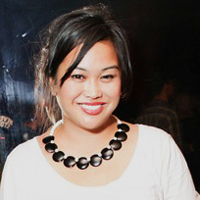Artist Carrie Mae Weems knows how to get the art world to pay attention to race, class, and gender. Her thought-provoking work intelligently depicts racial stereotypes and uses appropriated portraits of slaves to get her point across. Although she won a prestigious MacArthur “Genius” Grant Fellowship last year and her work is the subject of a current retrospective at the Guggenheim Museum in New York, Weems wasn’t always sure of her purpose in life.
Photos: Carrie Mae Weems Retrospective

After becoming a single mother at 16, joining Anna Halprin’s Dancer’s Workshop in San Francisco, and a failed attempt at a move to New York, Weems returned to San Francisco in 1971 and in 1973 worked as an organizer for a Marxist organization. It was a camera, given to her by her boyfriend for her 20th birthday in 1973 that changed everything. That camera gave Weems direction, leading her to study the images of Henri Cartier-Bresson and the African-American artist Roy DeCarava and to pursue studies in photography at San Francisco City College. She eventually received a BFA at the California Institute of the Arts, Valencia in 1981.
Weems has used her talent to explore issues of race, class, and gender, bringing the African-American experience to the forefront of the art world through her work’s depiction of racial stereotypes and use of historical references. Select parts of her 30-year oeuvre are currently on display at the Guggenheim in the retrospective Carrie Mae Weems: Three Decades of Photography and Video, open through May 14.
The retrospective begins with Family Portraits and Stories, Weems’s first major project, in which she took photographs of her family from 1978 to 1984. She depicts family members in a wide variety of situations, from a joyful reunion to her mother at work, and accompanies the photos with an oral history of her family. The artist intended for the project to serve as a response to a 1965 report by then Assistant Secretary of Labor Daniel Patrick that cited a weak family structure as the cause of “the deterioration of the fabric of Negro society.” She wanted to show that an average middle-class African-American family is more than just a set of statistics.
Following that is Weems’s seminal 1990 body of work, Kitchen Table Series—20 black-and-white gelatin prints partnered with 14 screen-print panels of text—that casts Weems as the protagonist in a fictional narrative of an African-American woman’s life as seen from a kitchen table. Her mother tends to her hair while giving her advice on men, she puts on makeup with her young daughter, and her partner grows increasingly distant because she is the breadwinner while he sits at home, unemployed.
Weems confronts African-Americans stereotypes head on, like the photos from her 1987 to 1988 Ain’t Jokin series. One image, titled “Black Man Holding Watermelon,” depicts an African-American man clutching a watermelon, while another, “Black Woman With Chicken,” shows an African-American woman sitting at a kitchen table holding a fried chicken leg in her hand.
Slavery is another theme Weems consistently probes in her work, from layering text over appropriated portraits of slaves for her mid-’90s series From Here I Saw What Happened and I Cried to venturing to the Sea Islands, off the coast of South Carolina and Georgia, in the early ‘90s to document the culture of the Gullah, ancestors of freed slaves who have formed a humble and deeply religious community there. In the 2003 Louisiana Project, she portrays herself dressed in the traditional housedress of a slave or domestic worker, standing against the sites of slavery and the backdrop of urban settings to examine the relationship between the south and its painful history. Weems also traveled abroad to Africa, Europe, and the Caribbean for the 2002 series Dreaming in Cuba, to examine the connection of these places to slavery and racism.
Also included in the exhibition is Weem’s video work, such as her 2009 piece Afro-Chic, which depicts women of various races strutting down the runway in Afros in front of a vintage poster of political activist Angela Davis and Black Panther member Huey Newton, conveying the notion that something that was once a symbol of the fight for equality has merely become a fashion statement.
The 60-year-old Portland, Oregon-born Weems isn’t just an artist, she also uses her status to make a hands-on social impact. She's involved with Operation Activate, which is a public art campaign in Syracuse, NY, (where she lives) that educates people on an initiative to stop gun violence, and the Institute of Sound and Style, which encourages inner-city youth to become involved in the arts. She also founded an artists’ collective called Social Studies 101, which helps art reach marginalized audiences.
While it is predominantly the African American journey that Weems has used as the focus of her work, she hopes that her art reaches a broad audience. She wants “people of color to stand for the human multitudes.”
Carrie Mae Weems: Three Decades of Photography and Video is on display at the Solomon K. Guggenheim Museum in New York through May 14.






